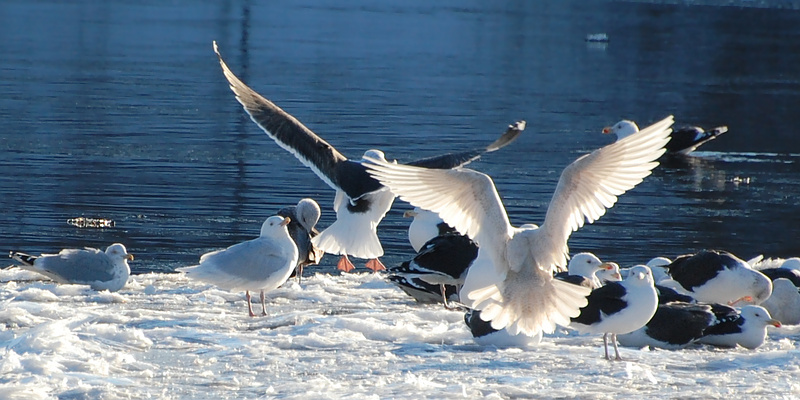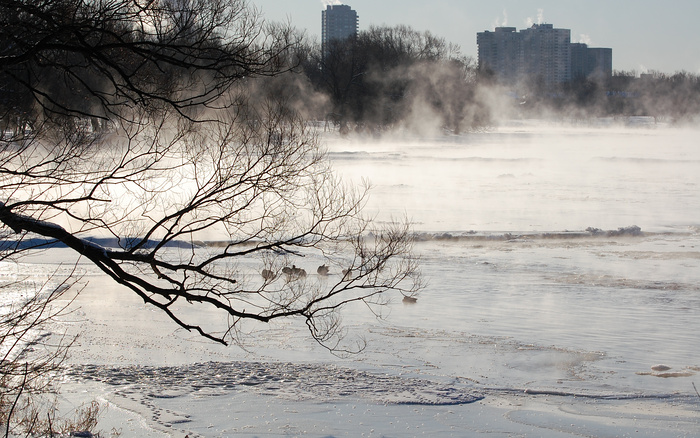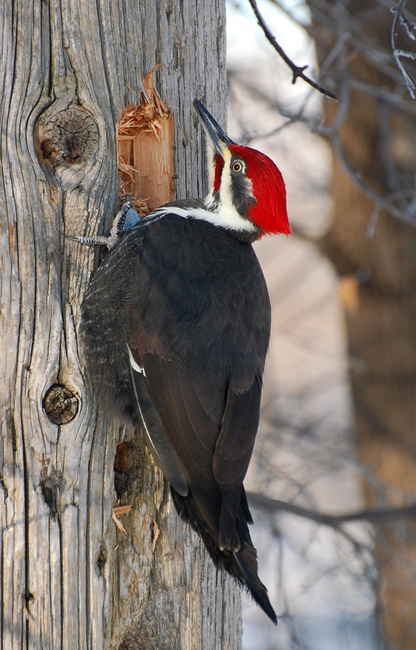
Answer: very carefully
January 27th, 2009
Responsible birding is often a balancing act, especially when dealing with rare or sensitive species. Wild Turkeys are one such. On the one hand, I want to keep my distance. I don't want to overstress these birds who have only recently been reintroduced to Ottawa and are struggling to survive our winters. On the other hand...Wild Turkeys! I live in a semi-urban apartment and there are freakin' Wild Turkeys practically in my back yard! How can a fanatic bird-watcher stay cool at a time like that?
I was watching "the gang of three" on Sunday, slowly creeping down the path towards them, camera in hand, trying to get them accustomed to my presence. Then a man with a golden retriever approached in the other direction. The feeding stopped, and all three heads bolted upright. They were stuck. Nowhere to run (turkeys prefer to run rather than fly whenever possible), thick brush and deep snow to either side, a man and a large dog on one end, and me with my suspiciously pointy-shooty thing on the other.
I knew they'd be able to get out of it, but I didn't like putting them under that kind of stress. So I walked back down the path and stepped off into the snow, avoiding the temptation to photograph them as they ran past.
Anyway, it all worked out. They ended up feeling so threatened by the dog that they flushed and went up into a tree. I put the sun behind me and got an excellent unobstructed view of one of them.

1680x1050 wallpaper
(The question, in case you didn't guess, is "how does a bird that big land in a tree without breaking the limbs off?")
Persona non grata
January 25th, 2009
Chickadees, goldfinches, starlings and woodpeckers were all having a blast at the Hurdman feeders today. Then all the activity stopped all of a sudden. The goldfinches disappeared and the chickadees began a non-stop chorus of "chick-a-dee-dee-dee-dee-dee-dee-dee!" Which, in chickadee speak, means "oh sh*t."
Shortly thereafter I spotted a Sharp-Shinned Hawk, a voracious eater of small songbirds, perched right above the feeder.


Wild Turkeys At Hurdman
January 24th, 2009
A "gang of three" (as the OFNC dubbed them) Wild Turkeys continue to frequent a bird feeder near Hurdman transit station.

Winter Gold
January 22nd, 2009

Wintering Glaucous Gulls
January 12th, 2009

Adult (second from left) and juvenile (the angelic-looking bird in flight) Glaucous Gulls, roosting with Great Black-Backed Gulls on the Rideau River. On the far left is a lone Herring Gull.
The composition of gull species in Ottawa changes almost entirely in winter. Ring-Billed Gulls (the guys you see in parking lots) leave and Herring Gulls dwindle, while Great Black-Backeds (the largest gulls in the world) move in by the hundreds, along with small numbers of more unusual species. Glaucous Gulls breed in the arctic and are a rare pleasure for Ottawa birders!
Canadian winter is a harsh mistress
January 4th, 2009

1680x1050 wallpaper
Found this juvenile Great Black-Backed Gull sitting alone on the ice edge of the Rideau River, looking forlorn.
Autumn Goldfinch
December 17th, 2008
I took this a few months ago, didn't get around to processing it until now.

Common Goldeneyes
December 15th, 2008
Common Goldeneyes are my favorite of all waterfowl. They spend the summer north of us, but in late fall hundreds of them arrive in Ottawa, and many stay throughout the winter, staking out patches of open water on the Rideau and Ottawa Rivers. If necessary, they'll cluster in the rapids when the rest of the water freezes over. They are amazingly hardy little ducks. These guys can be seen splashing and having a good time in twenty below, when even the overwintering Mallards are huddled up on shore hiding their faces from the wind.
Even the rough water of the Deschenes Rapids is not too much for them. They dive for food in the waves, all the while getting carried further and further downstream, until they have to use their wings to regain lost ground. They do this again and again, for hours. They never seem to run out of stamina.
But the Rideau River is the best place to see them up close in winter, in the stretch between Queensway (Hurdman) Bridge and Cummings Bridge. To pick them out among the more familiar Mallards and Blacks, look for smaller ducks who appear very white--those are the adult males. Up close they're quite handsome.


A young male making do with a narrow stream of open water.

Mallards behind.
How cold was it?
December 14th, 2008
A few wide-angle photos to set some context for the ones I'm posting tomorrow.


If you look closely at the second picture, you can see a male Common Goldeneye on the upper left. The ducks on the ice are Mallards.
A deep-winter Pileated Woodpecker
December 13th, 2008
Went out hiking at 8:30AM this morning. Two hours, -20 degrees Celsius (that's -4F for my American readers). It was wonderful. The sky was clear blue, the sun was shining. The Rideau River is gloriously ragged in such weather, like our own little corner of the arctic. Even the rapids had icebergs and ice fringes.
A male Pileated Woodpecker was the star of the show. For such magnificent and wild-looking creatures, Pileated Woodpeckers can be remarkably tame. This one was busily gouging an old wooden pole beside the river. He remained calm while I approached to within 10 feet, and circled the pole trying different angles. The only thing that sufficed to startle him was a very noisy mini snow plow going by. He skittered around to the far side of the pole, but came back a few seconds later.
And so here he is, with my thanks for being such a good sport!

1680x1050 wallpaper

|
